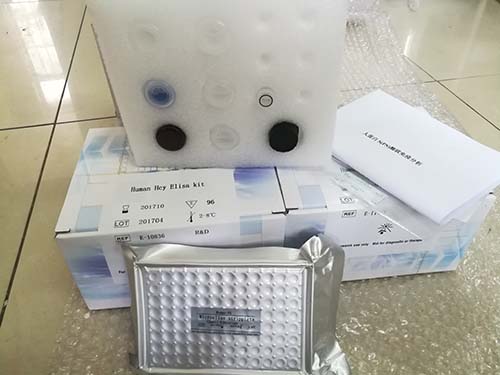Shrimp liver enterobacteria (EHP) nucleic acid detection kit (one-tube PCR-fluorescence probe method)
â—† Product Description
The animal disease detection series can amplify specific nucleic acid fragments of pathogenic organisms in samples such as water samples, baits, live birds, aquatic animals and related processed products, and judge the results by real-time amplification curves. This product is used for the detection of liver and intestinal worm (EHP) of shrimp. The detection limit is 10 3 copies/μL genomic DNA .
- Product composition (96 tests)
031122 Lâ…¡ | |
Reagent | content |
A-EHP-P | 20μL × 8 tubes × 12 rows |
NG-P | 100μL × 3 |
PG-EHP-P | 100μL × 2 |
- Applicable instrument
Real-time fluorescence PCR instrument such as ABI 7500, CFX 96, Mx 3005P, LineGene9600.
- Self-contained supplies and instruments
1 ice box; 2 pipettes (0.5-10μL, 10-100μL, 100-1000μL) and matching sterilization tips; 3 centrifuges; 4 vortex mixers; 5 metal baths; 6 homogenizers, mixers or Grinding tools such as mortar; 7 electronic balance.
â—† Notes
1. This reagent has high detection sensitivity. In order to prevent pollution, the experiment is to be partitioned.
1) First zone: sample preparation zone.
2) The second zone: the template addition zone.
3) Zone 3: Amplification and product analysis zone.
★ It is best to physically isolate the partitions to avoid contamination caused by human factors.
2. Work clothes and latex gloves are worn during the experiment, and tools are used independently in different areas. Gloves and lab coats need to be replaced.
3. Strictly follow the operation steps, reagent preparation and sample loading steps, please operate in strict accordance with the instructions on the ice box.
4. The components in the reaction solution are sensitive to light and should be stored away from light . The reagent should be completely thawed before use, but repeated freezing and thawing should be avoided. It is recommended to centrifuge for 30 seconds before use, and store the reaction solution in an appropriate volume according to the frequency of detection.
5. After the reaction is completed, the expansion tube should be placed in a sealed bag and discarded. On the same day, the lid is opened and the aerosol is easily contaminated. It is forbidden to open the lid.
6. Do not mix different batches of reagents used within the validity period.
â—† Sample processing
1 The collection and preparation of samples is an important step in the detection of shrimp liver enterobacteria. To prevent cross-contamination, disposable consumables should be used. The mortar should be dry-baked at 160 °C for 2 h. Other vessels that should not be dry-baked or high-pressure treated should be used. Soak in 1% sodium hypochlorite solution. 2 Sampling should take liver and pancreas as much as possible. For the same batch of samples, multiple points should be collected and combined, and then homogenized as one sample to extract DNA. 3 The sampling process should be completed quickly. The sample taken in a sterile homogenized bag is homogenized into a braid and mixed thoroughly.
- Experimental operation
1. Template preparation (sample preparation area)
Please refer to the extraction procedure of the instructions for rapid extraction of genomic DNA from aquatic animal diseases.
2. Add a template (template addition area, placed on the ice box)
Cut the PCR tube containing the reaction number, and place it at room temperature to be thawed. After centrifugation for 30 seconds, uncover the sealing film. Add 5 μL of template to each reaction solution in the order of NG, sample template to be tested. , PG-EHP-P. After the matching PCR tube cap was covered, the mixture was vortexed for 30 s, centrifuged for 1 min, and the PCR amplification reaction was immediately performed.
4. Amplification reaction (amplification and product analysis area)
Using a real-time PCR instrument, the fluorophore was selected for FAM and the quencher group was selected for TAMRA.
Set up the amplification reaction according to the following conditions:
PCR cycle | Fluorescence collection site | ||
95 ° C | 10 minutes | 1 cycle | - |
95 ° C | 15 seconds | 40 cycles | - |
60 ° C | 1 minute | ※ | |
For other instruments, please refer to the instrument manual for setting.
- Result determination
The test sample has no Ct value or ≥40, the curve is straight or slightly oblique, and there is no "S" type amplification curve, which can report negative samples, no EHP or lower than the detection limit;
The test sample Ct ≤ 36, the curve is an "S" type amplification curve, which can directly report the sample positive, containing EHP;
Test sample 36 Food Grade Phosphate,Dimagnesium Phosphate,Iron Pyrophosphate Powder,Ferric Diphosphate Wuxi Yangshan Biochemical Co.,Ltd. , https://www.yangshanchem.com